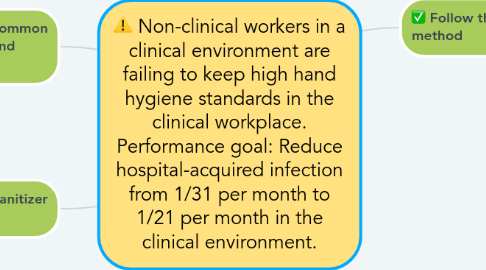Non-clinical workers in a clinical environment are failing to keep high hand hygiene standards in the clinical workplace. Performance goal: Reduce hospital-acquired infection from 1/31 per month to 1/21 per month in the clinical environment.
von Carrie Buckley


1. Understand the basics of common hospital acquired infections and diseases
1.1. Methicillin-resistant Staphylococcus ureus (MRSA).
1.2. Clostridium difficile (C. difficile.
1.3. COVID-19.
1.4. Escherichia coli (E. coli) .
2. Know when to use hand sanitizer or soap to wash your hands
2.1. Wash your hands with soap and water after touching any surfaces.
2.2. Use hand sanitizer if water and soap are not available (max 3 times before using soap and water).
2.2.1. 60% - 95% alcohol
2.3. Soap and water are more effective than and sanitizers at removing certain kinds of germs, like Cryptosporidium, norovirus, and Clostridium difficile.
3. Follow the 10 step handwashing method
3.1. 1) Wet hands with water.
3.2. 2) Apply enough soap to cover hands.
3.3. 3) Rub your hands together.
3.4. 4) Use 1 hand to rub the back of the other hand and clean in between the fingers. Do the same with the other hand.
3.5. 5) Rub your hands together and clean in between your fingers.
3.6. 6) Rub the back of your fingers against your palms.
3.7. 7) Rub your thumb using your other hand. Do the same with the other thumb.
3.8. 8) Rub the tips of your fingers on the palm of your other hand. Do the same with other hand.
3.9. 9) Rinse your hands with water.
3.10. 10) Dry your hands completely with a disposable towel and use it to turn off the tap.
4. Know when to wash your hands
4.1. Wash hands with soap after touching any surfaces.
4.1.1. - Your own hair or clothes.
4.1.2. - Other's hair, skin, clothing or personal items.
4.1.3. - Door handles, doors, room fittings and furniture.
4.1.4. - Items on the clinical ward and reception area.
4.1.5. After blowing your nose, sneezing or coughing.
